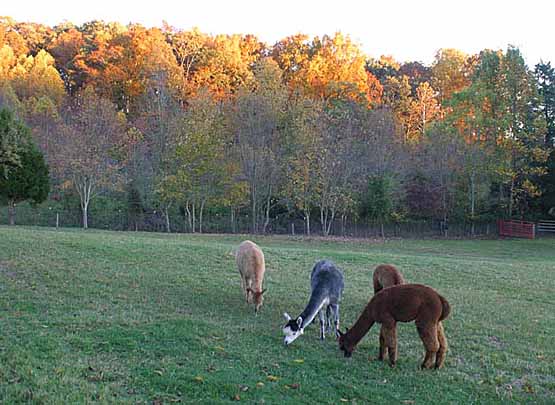|
Silver Thunder
Alpacas presents:
Alpaca Care and Feeding
Alpacas
Eat Grass and Hay All Day
Alpacas
are primarily grass eaters, feeding on hay or pasture.
The
alpacas free-graze in the pasture all day long. We also give them hay
each day. In the winter, when the grass is growing slowly or not at
all, we give them extra hay each morning for them to munch on throughout
the day. We buy Orchard Grass hay grown locally and baled in forty-pound
square bales. They eat about half a flake a day per alpaca. (For reference,
there's about eight flakes in a square bale of hay.) See footnote at
bottom of this page for more info on hay types.
Alpacas
Are Easy on the Pastures
Alpacas
are very easy on the pastures. Since they have pads instead of hoofs
on their feet, they don't churn up the ground, cause compaction of the
soil, and thus wreck the grass as cows and horses tend to do.
There's
another reason alpacas are easy on pastures: Because alpacas have only
bottom teeth that close against a top dental pad, rather than two sets
of teeth like horses, they do not destroy the grass roots as they eat.
Instead they clip the grass above the ground level, at a height that
allows the grass to grow back again quickly. Thus saving the pastures
and keeping them green all year long. Because they are so much easier
on the grass, it's possible to keep up to ten alpacas per acre of pasture.
(Compare this to cows, where it's recommended that there only be one
mother and her baby per acre.)
August, 2008 Note: Change in thinking due to two years of continuous drought. We are in the midst of dryness of historical proportions here in East Tennessee. For the second year we remain in a rain deficit, with our part of Tennessee currently at a Level 3: "Extreme" drought. While it's not as dry as last year (Level 4 - "Exceptional" drought - the worst you can get), it's still pretty bad. Having seen our pastures ravaged by two years of this drought, we have revised downward the number of alpacas that are recommended per acre. We think a better number in these difficult circumstances is four or five per acre.
Alpaca
Pellets and Special Treats
We
also supplement their forage intake with pellets once a day, normally
in the evening. These pellets are made from a mix of various grains
plus vitamins and minerals. They are specially formulated for alpacas
by feed mills which prepare the blends in conjunction with veterinary
advice. We combine two different brands: Mazuri
Alpaca Chews and Hallway Alpaca Developer. We like the Hallways best because of it's smaller pellet size. See footnote below for a lot more pellet info.
To
the pellets we add some additional vitamin and mineral supplements.
Made by a company called Stillwater
Minerals, they are in powdered form. (We buy them online
through Useful
Lama Items.) The supplements are made especially for alpacas
to help them run faster, jump higher, and have nice straight legs. We
add a pinch per animal each day to their pellets.
Besides
their daily feeding, we also often feed the alpacas pellets by hand:
To build animal confidence in socializing with people or as a reward
for good behavior when halter training. Or just as a special treat.
(Mostly because it's fun for us...)
Another
special treat we like to offer the alpacas is baby carrots. They'll
eat them right out of your hand and will come running to the fence if
they see you have some. "Oh, looky, the two-leggers have those
orange crunchy things again, let's go get some." Boy do they come
running. It's enjoyable for both them AND us.
Alpaca
Vet Care
Alpacas
are easy to care for, as they are excellent at taking care of themselves.
They pretty much know what they need, so we just make sure they have
plenty of grass and good clean water. We have vets on call that specialize
in camelids (alpacas are members of the camel family), but it's only
on rare occasions that we need to use them. Speaking of how much easier
alpacas are to care for than other animals, I once heard a vet say,
"If these were horses, we'd be out here a lot more often."
Alpacas tend to be more disease-resistant than other livestock.
One
other point about vets: A surprisingly large number of alpaca owners
are veterinarians. That is a very good sign for this industry. When
someone with hard training and long experience buys the very animals
they work with, it speaks volumes about the quality of the alpaca business.
They know a good thing when they see it.
Alpacas
Are The Ideal Small-Acreage Livestock
Take
all these things together, and you can see why alpacas are considered
the ideal small-acreage livestock. Let us show you. We'd love to have
you come visit our alpacas and learn about them close up. If nothing
else, it's amazingly therapeutic to just watch and listen as they contentedly
graze. Standing in the field and listening to the soft tearing of grass
and the quiet munching sounds is very comforting. Sort of slows time
down just a bit. Makes you glad to be alive. Come and see.
Please feel free to call or email and we'll be glad to arrange a visit
at a time that suits you best. C'mon over. You'll have a great time.
Thanks again for
visiting,
Chuck and Nancy
Silver
Thunder Alpacas
Making
great alpacas in Greeneville,
Tennessee
Pure
Bred and Hand Fed!
Footnote:
Good Hay, Bad Hay
There
are a couple other kinds of hay that are good for alpacas. Timothy hay
is excellent, with lots of nutrients. (The same goes for the Orchard
Grass that we use.) Bermuda is good, as it's very hardy, though it's
protein content is a bit lower than some others.
Keep
this in mind about hay: A given amount of hay will have more nutritional
content than the same amount of pasture grass. That's because protein
in the hay has been concentrated during the drying process. There's
less water, thus less weight, so the animals get more nutrition out
of each bite.
There
are a few hay types we stay away from. We avoid Alfalfa hay (except
in small amounts as a special treat for pregnant mommas or for extra warmth in winter) because it is too rich for them
due to its high protein content. Alpaca's digestive systems are very
efficient, so food that's too rich can cause ouchy stomachs. Same for
Clover hay, and in addition, the white clover being avoided because
the seeds become trapped in their teeth, causing excessive foaming (same
as it does in horses) that can possibly lead toward ulcers in alpacas.
We also don't put the expectant-mother alpacas on Fescue hay (or pastures)
in their last trimester. Fescue (the most common type of hay around
here - or as one hay person put it to me: "God's favorite weed") is bad since most of it has endophytes (a soil parasite) that
can lead to birthing problems in pregnant females due to a thickened
placenta and may also cause difficulty in a momma's milk coming in. We also avoid perennial ryegrass (though annual is ok) because
it releases a toxin that leads to "the rye grass staggers".
Footnote:
About Pellets
Mazuri Alpaca Chews and Hallway
Alpaca Developer are the pellets we use. We like the Hallways the best. (It's cheaper and the alpacas seem to like the smaller pellet size. Plus the smaller pellets help to reduce choke.) Both of these feeds
use Dr. Evens' formulas for proven alpaca nutrition. I've created links
to both sites, but note that the Hallway link is only to their corporate
website. (While Hallway is the premier feed in horse racing, they don't
yet list the Alpaca Developer on their website.) The Mazuri is a larger
pellet (approx. 1/2 inch long x 1/8" around), while the Hallway
is a smaller pellet about half the size (approx. 3/8" long and
1/16" around). We order these through our local feed stores in Greeneville, each
product from a different feed store, as it turns out, because each store
has different sources. (For locals: We use F&M on Irish St. for Hallways and Broyles on S. Main for Mazuri.)
For
our pregnant females, or those that are nursing babies, we use Evens
S/G/L, a feed blend formulated by Dr. Evens and sold by Blue Seal. (S/G/L
stands for Starter, Gestation, Lactation.) Not only do the alpacas really
seem to enjoy it, but it's also cheaper than the others. (Though we
have to drive 70 miles to get it from Little Mountain Farm Supply in Tryon, North Carolina.) Here is link to the Blue Seal web page for alpaca feed. Also on the their site is a link to find a Blue Seal dealer near you.
A Note About "Choke"
Choke is what happens if alpacas try to eat their pellets too fast. It's fairly rare, but scary to watch. They cough and sneeze and foam at the mouth while attempting to free the obstruction in their throat. The first time you see it you worry they are going to die. But they don't. After 10 or 15 minutes (it seems like forever) they manage to work the blockage loose on their own. At times we try to help by massaging the left side of the neck to help loosen the clump. There is not much else you can do, as it is not possible to do a Heimlich Maneuver on an alpaca.
There are a few things we have used at times to help reduce choke before it happens. A pellet trick we learned from John and Tina, our mentors at Pacifica,
is to add a bit of water to the mix before serving it to the alpacas.
This allows the pellets to absorb the water and expand slightly, which
helps lessen the likelihood of choking problems. A further choke-reducing
method is to add fist-sized rocks to the feeding bins to force the animals
to eat around them, thereby slowing down their feed intake. At times we have used a different feed from Mazuri: Alpaca Crumbles.
The crumbles are even smaller than the Hallway pellets. They are almost
like crushed up pellets, sort of a course granular texture (a lot like Grapenuts cereal). Mixing the Alpaca Crumbles together with the Hallway's smaller pellets has helped reduce our choke problems significantly.
We don't use all the above methods all the time, only if a particular animal seems to have a recurring problem. In recent years we have taken to using smaller bins for feeding, rather than long troughs. This seems to lessen choke as well, and thankfully we rarely see it anymore.
Click here to return
to the top of this page: Alpaca
Feeding.
Click here to return
to the Silver Thunder
Home Page. Or just click on the Silver Thunder logo in
the top left corner of any page on this site to return to the home page.
 Proud to be an
American. Proud to be an
American.
This
page last updated 12/23/08
|











